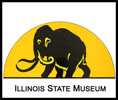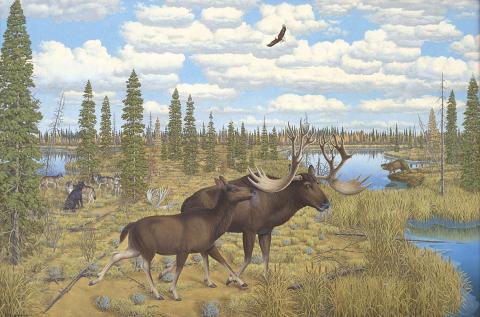Forest Tundra
Forest Tundra reconstruction at the Tonica Kettle site, LaSalle County, IL. By Robert Larson.
Steppe and forest tundra characterize the landscape at glacial margins, at the height of late Wisconsinan glaciation in the Great Lakes region. This environment has no modern analogue. In more mesic eastern parts of the Midwest, trees were more common landscape elements in tundra-like environments, thus the name Forest Tundra. Uplands would been predominantly grasslands, with occasional trees (Spruce and Larch). Lowland areas were moderately wet, with willow, sedges, and herbs dominant. Two species commonly found in this biome, Willow and Dryas, are early successional species, able to pioneer stony and gravelly habitats such as glacial outwash deposits (Curry and Yansa 2004). Annual temperatures were 5 to10 degrees celcius less than modern (Jackson et al. 2000).
Animals present in this environment were able to survive severe cold. In forest tundra areas of the Midwest, these species included large, grazing herbivores like mammoths, caribou, and elk-moose, as well as the semi-aquatic giant beaver. Although few predators are present in the fossil record of the region, the carnivore guild likely included apex predators such as Scimitar cat and Dire Wolf, as well as large omnivores like short-faced bear. Many megaherbivores performed key ecological functions such as providing needed nutrients in early successional environments (through manure) or grazing mature vegetation to increase biological diversity. When animals perform key ecological roles within an ecosystem, they are called "keystone" species. When keystone species go extinct, those ecological functions are no longer present and the entire ecosystem changes.
Biological communities occupying the Tundra-like landscapes of the Midwest during the last glacial maximum were very adapated to cold and arid environments. However, glaciers and peri-glacial environments also produce changes in the underlying geology. Features such as ice-walled lakes, pingos, and patterned ground can still be seen on the modern day surface of glaciated areas.
- Northeastern Illinois: 21,700-16,200 cal BP (Curry and Yansa 2004, Currey et al. 2010)
- Eastern Wisconsin: after 14,500 cal BP (Maher et al. 1998)
- Lower Michigan: ~12,000 cal BP (Larson et al. 1994)






